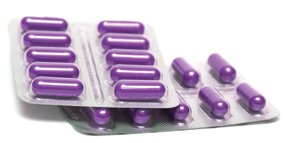PPI's benefits can outweigh their possible risks
The key to proper use of proton-pump inhibitors is monitoring patients closely to determine if they are benefitting from long-term therapy, or could potentially discontinue or reduce their dose.
Beth Schorr-Lesnick, MD, FACP, used to keep all of her symptomatic patients with reflux on proton-pump inhibitors (PPIs). Now, she said, “Those days are gone.” Research indicating risks of PPIs, especially with long-term use, have made physicians a bit more cautious about the therapy.
“I worry more about high doses and wonder if they should be cut back a little,” said Dr. Schorr-Lesnick, a gastroenterologist and clinical assistant professor at Albert Einstein College of Medicine in New York. “I talk to patients more about potential side effects and possible alternatives to PPIs.”

PPIs are still an excellent choice for the treatment of gastrointestinal reflux disease, and the newly quantified risks, such as enteric infections and bone fractures, are usually minor compared with the benefits for appropriate patients, experts said.
“As long as these drugs are used appropriately for patients who genuinely require them, then the benefits greatly outweigh the risks,” said Colin W. Howden, MD, a gastroenterologist and professor of medicine at Northwestern University's Feinberg School of Medicine in Chicago.
Dr. Howden points to the most recent guidelines on GERD management from the American Gastroenterological Association (AGA), published in 2010, which recommend long-term use of PPIs for patients with esophagitis, titrated down to the lowest effective dose to control symptoms.
The key to proper use of PPIs, said Dr. Howden and other experts, is monitoring patients closely to determine if they are benefitting from long-term therapy; whether they might be able to discontinue or reduce their dose or switch to another medication; and whether the PPI is working to relieve their symptoms (if not, GERD may not be the correct diagnosis).
“The hardest part is deciding when or whether to stop PPIs,” said Douglas S. Paauw, MD, MACP, professor of medicine at the University of Washington School of Medicine in Seattle. “For many patients it becomes a chronic medication. But if you put someone on a PPI, you always need to question whether you should keep them on it.”
When to prescribe
Dr. Lesnick said her decision-making process about whether to prescribe a PPI has changed over the years as studies have revealed potential risks associated with long-term use.
“I tend to start functional heartburn patients on an H2 blocker [histamine-2 receptor antagonist] and work up to a PPI if they don't respond to it,” she said. “For patients who have mucosal disease on endoscopy, I'll start them on a PPI and work down to the lowest dose that controls the symptoms after eight weeks or so of daily PPI therapy. Ultimately, they may be controlled on every-other-day dosing or alternate with H2 blockers. If their disease is mild, I might even switch them to an H2 because it's less potent and has fewer side effects.”
Prashanthi Thota, MD, a gastroenterologist at the Cleveland Clinic in Cleveland, said patients with mild or occasional symptoms of heartburn often do well on an H2 blocker. She starts patients with more severe symptoms on 40 mg of a PPI (20 mg taken twice daily) for three months, then reduces the dose gradually if their symptoms are under control.
It's also important to take a careful history to determine what's really causing a patient's symptoms, said Norton J. Greenberger, MD, MACP, clinical professor of medicine at Harvard School of Medicine in Boston. If symptoms are triggered by certain foods, such as acidic beverages or chocolate, he recommends dietary changes along with medical therapy.
Dr. Greenberger also asks patients to log their symptoms for the first few months of treatment to assess whether 20 mg per day is enough to control them or whether they need a second dose at night to control breakthrough internal acid secretion. He tries to eventually wean patients off the second dose if their symptoms improve.
It's important to monitor any changes in weight during treatment, he added. “If a patient has gained 15 pounds, it can worsen his symptoms, whereas symptoms may improve if the patient loses as little as 10 pounds.”
Ultimately, the degree and nature of individual patients' symptoms dictate how to balance the overall risks and benefits of prescribing PPIs, according to a 2011 editorial in Annals of Family Medicine. For patients with potentially serious conditions such as acute gastric or duodenal ulcers, for example, the benefits of PPI treatment far outweigh the risks, the authors noted.
However, “the balance of risks and benefits would be quite different in patients who are being treated primarily for symptoms with little risk of serious complications,” such as nonspecific dyspepsia, which current guidelines recommend treating with PPIs for no more than six weeks, the authors continued. “Using PPIs for long-term therapy maintenance in these cases is usually not appropriate and probably represents the most common reason for overuse of PPIs.”
The editorial cited maintenance therapy for GERD as another area where PPIs are overused.
“Regarding continuation or maintenance therapy, a good rule of thumb is to use the lowest effective maintenance dose for long-term control,” meaning once-daily therapy for patients with erosive esophagitis or Barrett's esophagus and on-demand therapy only for GERD patients without complications, they said.
Potential risks
Recent studies have found an association between PPI use and fracture risk, although the risks do not appear to outweigh the benefits of treatment for most patients.
A 2010 prospective analysis of the Women's Health Initiative, which included 161,806 postmenopausal women ages 50 to 79, found that use of PPIs was modestly associated with spine, forearm or wrist, and total fractures, with hazard ratios of 1.47, 1.26 and 1.25, respectively.
However, the authors noted that although the study is important for its large and diverse sample size, participants may have had an overall higher than average risk for fractures, and there was a relatively low prevalence of long-term PPI use among those studied.
A 2011 meta-analysis in Annals of Family Medicine found a possible association between PPI use (but not H2 blockers) and a modestly increased fracture risk, prompting the authors to advise physicians to carefully consider whether to prescribe PPIs to any patient with an existing elevated risk of fracture, especially women older than age 65.
The authors noted, however, that the association between PPI use and fractures was weak, with a pooled odds ratio of 1.29, and that the analysis was limited because only observational studies were included.
Physicians such as Dr. Howden discuss these findings with their patients but believe the evidence doesn't support withholding PPI treatment when it is the most effective and appropriate option, or justify prescribing supplements to counterbalance the possible risk of fractures.
“Just because a patient is on a PPI, no extraordinary measures are indicated for prevention of fractures,” said Dr. Howden. “Patients should receive all age-appropriate treatments for bone mineral density, but I don't routinely prescribe calcium or vitamin D just because a patient is on a PPI.”
The potential risk of fractures definitely should not prevent physicians from prescribing a PPI in cases where patients are taking nonsteroidal anti-inflammatory drugs (NSAIDs), experts noted, because PPIs protect against the risk of gastrointestinal (GI) complications conferred by NSAIDs.
“Data shows that PPIs reduce the risk for ulceration and GI bleeding when patients are taking NSAIDs,” said Dr. Paauw. “If you are going to use an NSAID every day, you should add a PPI, especially in elderly patients.”
Similarly, physicians often prescribe PPIs to patients taking clopidogrel to reduce the risk of bleeding. However, concerns have been raised by studies suggesting that PPIs may reduce the antiplatelet effects of clopidogrel.
Whether to continue with PPIs in patients taking clopidogrel should hinge on the patient's degree of risk for recurrent gastrointestinal bleeding, according to a 2010 consensus statement by the American College of Cardiology Foundation, the American College of Gastroenterology and the American Heart Association.
The statement recommends PPI use for patients with a history of upper gastrointestinal bleeding as well as for patients with multiple risk factors for bleeding, including advanced age; concurrent use of anticoagulants, steroids or NSAIDs; and Helicobacter pylori infection.
Some physicians try to mitigate the possible negative interaction between PPIs and clopidogrel by advising patients to take the medications 12 hours apart, but the statement noted that no conclusive evidence supports this strategy.
There is some evidence that omeprazole is more likely than other PPIs to interfere with the effectiveness of clopidogrel, the AGA statement noted, suggesting that switching to another PPI may be an option.
However, the variation among PPIs has not been shown to affect clinical outcomes. And an observational cohort study and self-controlled case series of U.K. patients published in BMJ this July found that the interaction between PPIs and clopidogrel was clinically unimportant.
Research has also suggested that PPI use may increase a patient's risk of Clostridium difficile infection among hospitalized patients. A study published in the April 2012 American Journal of Gastroenterology concluded that PPI therapy was associated with a near-doubling in the risk for acquiring C. difficile and recurrence. The authors called for a critical review of the widespread use of PPIs among hospitalized patients, as there is evidence that many patients who were infected with C. difficile did not require PPI therapy.
However, C. difficile infection shouldn't be a major concern for most patients who are taking PPIs outside of the hospital, several physicians said.
“PPI use alone is a weak risk factor for infection,” said Dr. Howden. “Antibiotic use or being sick, being in the hospital, kidney impairment, treatment for cancer are all much greater risk factors for C. diff than taking a PPI. A sick, elderly person taking antibiotics is already at risk for C. diff infection. If that patient needs to take a PPI, they should take one because the benefits outweigh the risks.”
When PPIs don't work
If a patient doesn't seem to be getting relief from PPI therapy, the first thing to check is whether he is taking the medication correctly, said M. Michael Wolfe, MD, FACP, chair of medicine at MetroHealth and the Rammelkamp Professor of Medicine at Case Western Reserve University School of Medicine in Cleveland.
“One of the biggest errors doctors make is not giving instructions about how to take PPIs,” said Dr. Wolfe, an expert in acid-related gastrointestinal disorders. Patients should take the pill in the morning about a half-hour before eating breakfast, he said, but physicians often fail to emphasize the importance of that timing or patients ignore instructions.
If a patient is taking the medication correctly but still experiences symptoms, AGA guidelines recommend increasing therapy to two doses per day, the second dose to be taken 30 minutes before dinner at night.
A recent study found that twice-daily dosing not only improved symptom relief for patients with reflex esophagitis who were not cured by the standard eight-week therapy but also resulted in endoscopically confirmed healing. The study, published in the March 2012 American Journal of Gastroenterology, concluded that a twice-daily dose of rabeprazole (20 mg and 10 mg) led to a significantly higher healing rate after eight weeks than once-daily therapy of 20 mg.
However, stepping up the dose won't help patients who have no response at all to initial treatment, noted Dr. Howden.
“If a patient has been put on a PPI for symptoms thought to be due to acid reflux and reports zero improvement in symptoms after two to four weeks, it would be a waste of time to change from one PPI to another or increase the dose,” Dr. Howden said. “I would stop the PPI and consider another diagnosis.”
Some patients may get relief from heartburn after initial treatment but still experience symptoms of reflux like regurgitation, he added. These patients are a “significant management challenge,” he said, because PPIs are not as effective for managing regurgitation as they are at controlling heartburn.
Anti-reflux surgery is an option for some patients. AGA guidelines recommend considering it when a patient with GERD responds to PPIs but experiences other ongoing symptoms, such as troublesome regurgitation. However, it is not a solution for patients who don't respond to PPI therapy.
“That may sound counterintuitive because doctors tend to think that if a patient doesn't respond to medical treatment, you go to surgery,” Dr. Howden said. “But GERD is not like that. The PPIs are so specific for acid reflux that if a patient has little or no response, [the patient] likely doesn't have acid reflux and you expose him or her to the risks of surgery unnecessarily.”
Ultimately, knowing whether to step up, step down or discontinue PPIs depends on carefully monitoring patients undergoing therapy, said Dr. Schorr-Lesnick. Although the benefits of therapy outweigh the risks for most patients, she said, knowing that risks exist requires physicians to be more vigilant about management. She likes to see her GERD patients twice a year.
Managing PPI therapy is “a challenge for physicians,” said Dr. Paauw, “because none of the risks is a deal-breaker if the patient really needs a PPI. But if they don't need it, they shouldn't take it, because there are side effects that we know about now.”





